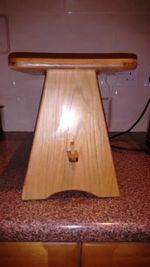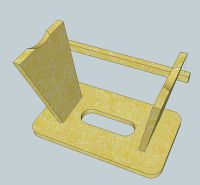Difference between revisions of "Talk:Traditional wooden stepping stool"
Jump to navigation
Jump to search
(Safety against tipping) |
m (Comments on design) |
||
| Line 2: | Line 2: | ||
The standing-on part of a stepping stool should never overhang its effective footprint. [[User:John Stockton|John Stockton]] ([[User talk:John Stockton|talk]]) 12:21, 19 October 2015 (BST) | The standing-on part of a stepping stool should never overhang its effective footprint. [[User:John Stockton|John Stockton]] ([[User talk:John Stockton|talk]]) 12:21, 19 October 2015 (BST) | ||
| + | |||
| + | : I am not sure the photos really show it from the best angles, but in general the base footprint and top are actually quite similar in shape. Across the narrow axis the base width matches the narrowest part of the top - this means that since the top has slightly scalloped sides, the corners overhang by about 1/2". You can see that in this photo [[image:StepStoolEndView.jpg|150px]]. | ||
| + | |||
| + | : End to end, the footprint is actually wider than the top due to the splay of the legs, but I have not got a photo that shows that particularly well. You can probably see it best from the illustration | ||
| + | :[[image:StepStoolOfferUpStretcher.jpg|200px]] | ||
| + | |||
| + | : In use it seems stable enough, and certainly feels far safer than the commercial plastic thing that exploded under me and thus inspired its creation ;-) Having said that, I am quite happy to add a warning to the article to highlight this aspect of the design and its significance. --[[User:John Rumm|John Rumm]] ([[User talk:John Rumm|talk]]) 09:48, 23 October 2015 (BST) | ||
Latest revision as of 08:48, 23 October 2015
Safety
The standing-on part of a stepping stool should never overhang its effective footprint. John Stockton (talk) 12:21, 19 October 2015 (BST)
- I am not sure the photos really show it from the best angles, but in general the base footprint and top are actually quite similar in shape. Across the narrow axis the base width matches the narrowest part of the top - this means that since the top has slightly scalloped sides, the corners overhang by about 1/2". You can see that in this photo
 .
.
- End to end, the footprint is actually wider than the top due to the splay of the legs, but I have not got a photo that shows that particularly well. You can probably see it best from the illustration

- In use it seems stable enough, and certainly feels far safer than the commercial plastic thing that exploded under me and thus inspired its creation ;-) Having said that, I am quite happy to add a warning to the article to highlight this aspect of the design and its significance. --John Rumm (talk) 09:48, 23 October 2015 (BST)